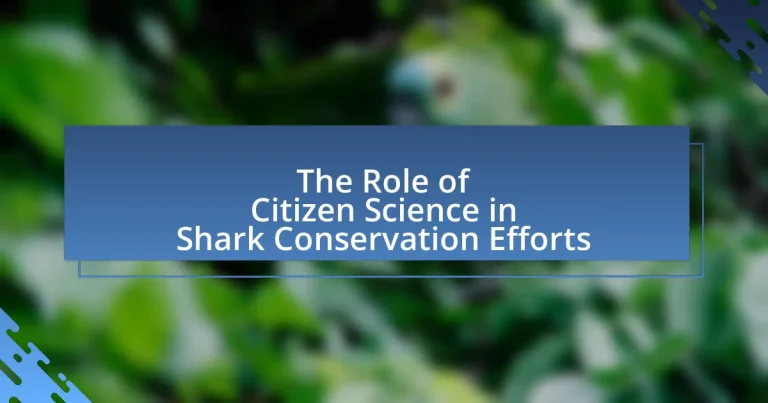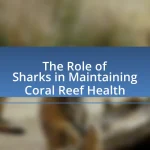Citizen science is a vital component of shark conservation efforts, engaging the public in data collection and monitoring activities that enhance understanding of shark populations and their habitats. Programs such as the Shark Trust’s “Shark Spotters” and “Shark Watch” initiatives demonstrate how volunteer involvement can yield reliable data, informing research and policy decisions. Key activities include species identification, habitat monitoring, and reporting shark sightings, which contribute to comprehensive conservation strategies. Despite challenges like data quality and participant engagement, successful citizen science projects have shown significant impacts on public awareness and effective conservation outcomes.
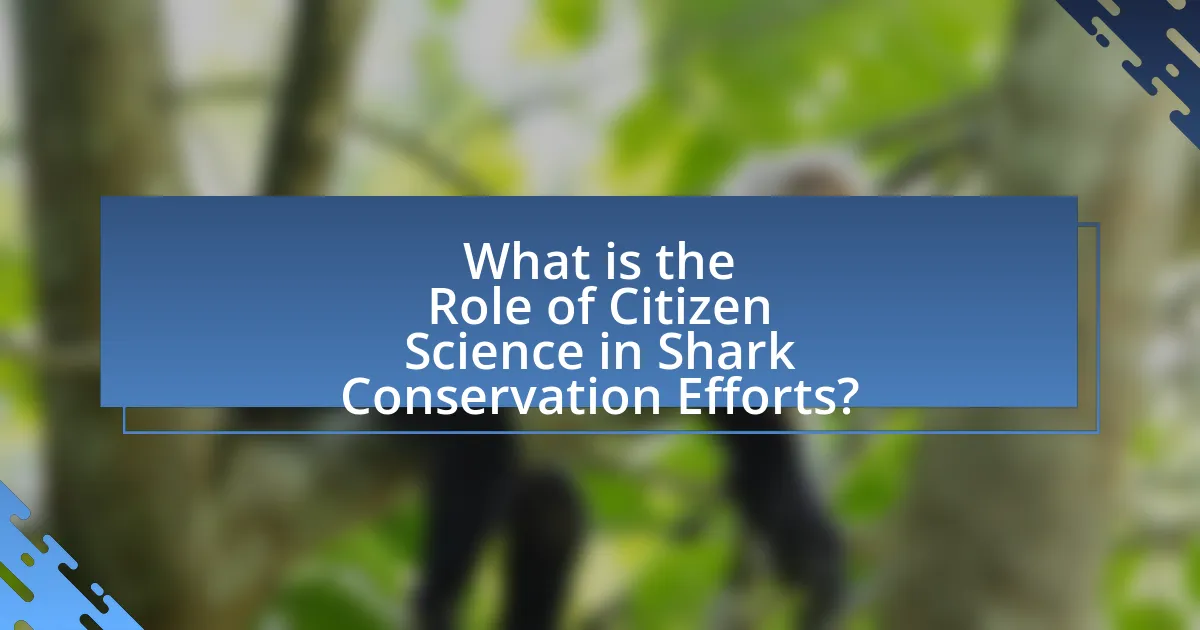
What is the Role of Citizen Science in Shark Conservation Efforts?
Citizen science plays a crucial role in shark conservation efforts by engaging the public in data collection and monitoring activities. This involvement enhances the understanding of shark populations, their behaviors, and habitats, which are essential for effective conservation strategies. For instance, programs like the Shark Trust’s “Shark Spotters” initiative utilize volunteers to report shark sightings, contributing valuable data that informs research and policy decisions. Studies have shown that citizen-collected data can be as reliable as that gathered by professionals, thereby increasing the volume of information available for conservation efforts.
How does citizen science contribute to shark conservation?
Citizen science significantly contributes to shark conservation by engaging the public in data collection and monitoring efforts. This involvement enhances the understanding of shark populations and their habitats, as citizen scientists often gather valuable information on species distribution, behavior, and threats. For instance, initiatives like the Shark Trust’s “Shark Spotters” program have successfully utilized volunteers to report shark sightings, leading to improved data on shark movements and increased awareness of their conservation needs. Such collaborative efforts not only bolster scientific research but also foster community stewardship, ultimately aiding in the protection and management of shark species.
What are the key activities involved in citizen science for sharks?
Key activities involved in citizen science for sharks include data collection, species identification, and habitat monitoring. Participants engage in activities such as reporting shark sightings, tagging sharks, and contributing to databases that track shark populations. These efforts help researchers gather valuable information on shark behavior, distribution, and conservation status. For instance, programs like the Shark Conservation Society’s citizen science initiatives have successfully documented over 10,000 shark sightings, providing critical data for conservation strategies.
How do citizen scientists collect data on shark populations?
Citizen scientists collect data on shark populations primarily through structured observation and reporting methods. They participate in activities such as beach surveys, where they document shark sightings, and use tools like smartphone apps to record data on species, size, and behavior. For instance, programs like the Shark Spotters initiative in South Africa engage local volunteers to monitor shark activity and report their findings, contributing to a larger database that researchers analyze for trends in shark populations. This collaborative approach enhances the understanding of shark distribution and behavior, supporting conservation efforts.
Why is citizen science important for shark conservation?
Citizen science is important for shark conservation because it enhances data collection and public engagement in research efforts. By involving non-professionals in monitoring shark populations and habitats, citizen scientists contribute valuable observations that can lead to more comprehensive data sets. For instance, initiatives like the Shark Trust’s “Shark Watch” program have shown that citizen-reported sightings can significantly increase the understanding of shark distribution and behavior. This grassroots involvement not only aids scientific research but also fosters a sense of stewardship among participants, promoting conservation awareness and advocacy within communities.
What impact does citizen science have on public awareness of shark issues?
Citizen science significantly enhances public awareness of shark issues by actively involving individuals in data collection and research efforts. This engagement fosters a deeper understanding of shark conservation challenges, as participants learn about the ecological importance of sharks and the threats they face, such as overfishing and habitat loss. Studies, such as those published in the journal “Conservation Biology,” demonstrate that citizen science initiatives lead to increased knowledge and concern about marine biodiversity, including sharks. Furthermore, programs like the Shark Trust’s citizen science projects have shown that participants often share their experiences and findings within their communities, amplifying awareness and advocacy for shark conservation.
How does citizen science enhance traditional conservation methods?
Citizen science enhances traditional conservation methods by increasing data collection and public engagement in conservation efforts. This approach allows non-professionals to contribute valuable observations and data, which can lead to more comprehensive monitoring of species and ecosystems. For instance, studies have shown that citizen scientists can gather large volumes of data on shark populations, helping researchers track changes over time and identify critical habitats. The involvement of the public not only enriches the data pool but also raises awareness and fosters a sense of stewardship among communities, ultimately supporting more effective conservation strategies.
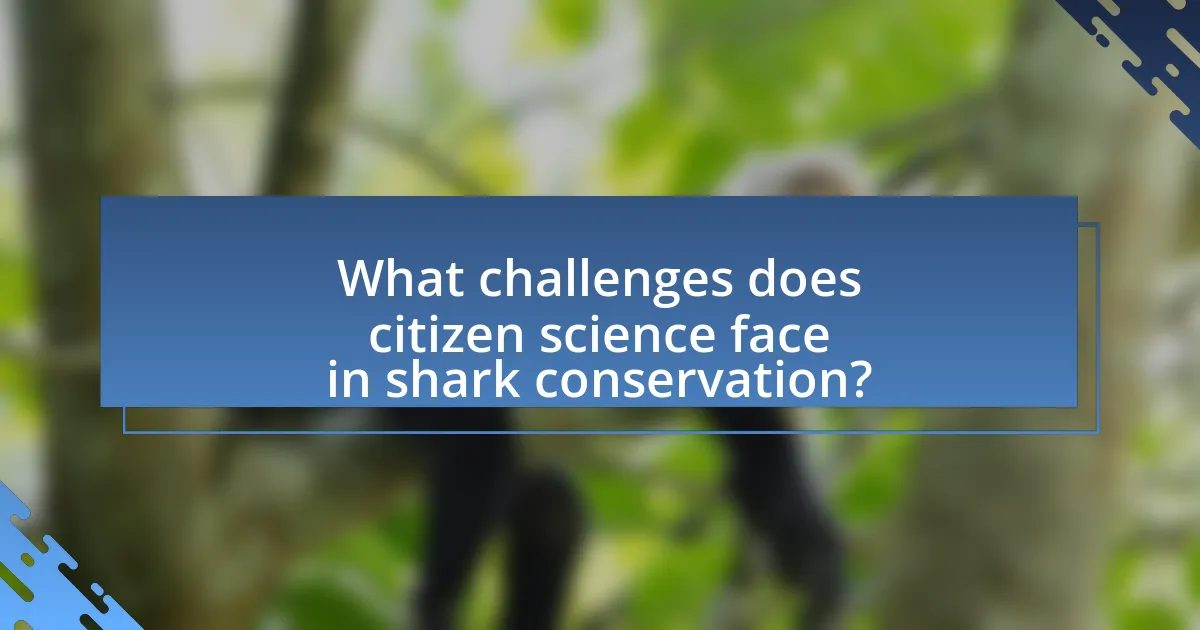
What challenges does citizen science face in shark conservation?
Citizen science in shark conservation faces challenges such as data quality, participant engagement, and resource limitations. Data quality issues arise from varying levels of expertise among volunteers, which can lead to inconsistent or inaccurate data collection. For instance, a study published in the journal “Conservation Biology” highlighted that non-expert observations often lack the precision required for effective conservation strategies. Participant engagement is another challenge, as sustaining interest and motivation among volunteers can be difficult, particularly in long-term projects. Additionally, resource limitations, including funding and access to technology, hinder the ability to train volunteers and implement effective monitoring programs. These challenges collectively impact the effectiveness of citizen science initiatives in contributing to shark conservation efforts.
What are the limitations of citizen science in this field?
Citizen science in shark conservation efforts faces several limitations, including data quality, participant variability, and resource constraints. Data quality can be compromised due to the varying levels of expertise among citizen scientists, leading to inaccuracies in species identification and reporting. A study published in the journal “Conservation Biology” highlights that non-expert observations can introduce significant errors, affecting the reliability of the data collected. Participant variability also poses challenges, as differences in motivation, training, and commitment can lead to inconsistent data collection practices. Additionally, resource constraints, such as limited funding and access to technology, can hinder the effectiveness of citizen science initiatives, restricting the scope and scale of conservation efforts.
How can data quality be ensured in citizen science projects?
Data quality in citizen science projects can be ensured through rigorous training, standardized protocols, and validation processes. Training volunteers on data collection methods enhances their understanding and accuracy, while standardized protocols provide clear guidelines that minimize variability in data collection. Additionally, implementing validation processes, such as cross-checking data against expert assessments or using automated quality control tools, helps identify and correct errors. Research indicates that projects employing these strategies, like the “SharkNet” initiative, have demonstrated improved data reliability, leading to more effective conservation outcomes.
What are the common misconceptions about citizen science in conservation?
Common misconceptions about citizen science in conservation include the belief that it lacks scientific rigor, that it is only for amateurs, and that it cannot contribute to significant conservation outcomes. Many people assume that data collected by non-professionals is unreliable; however, studies have shown that citizen-collected data can be as accurate as that gathered by trained scientists, particularly in biodiversity monitoring (e.g., the research by Theobald et al. in 2015). Additionally, the notion that citizen science is solely an amateur endeavor overlooks the fact that many projects involve collaboration between scientists and volunteers, enhancing the quality of research. Lastly, the idea that citizen science cannot lead to meaningful conservation results is contradicted by successful initiatives, such as the involvement of citizen scientists in tracking shark populations, which has informed management strategies and policy decisions.
How can these challenges be overcome?
Citizen science can overcome challenges in shark conservation by enhancing data collection and public engagement. By involving local communities in monitoring shark populations, citizen scientists can provide valuable data that complements professional research efforts. For instance, studies have shown that citizen-collected data can be as reliable as that gathered by trained scientists, as demonstrated in the research by Theobald et al. (2015) published in “Ecological Applications,” which highlighted the effectiveness of community involvement in biodiversity monitoring. Additionally, educational programs can raise awareness about shark conservation, fostering a sense of responsibility and encouraging sustainable practices among participants. This dual approach of data collection and education can significantly mitigate the challenges faced in shark conservation efforts.
What strategies can improve citizen engagement in shark conservation?
To improve citizen engagement in shark conservation, strategies such as educational outreach programs, community-based conservation initiatives, and the use of technology for citizen science can be implemented. Educational outreach programs, like workshops and school curricula focused on shark biology and conservation, have been shown to increase awareness and interest among community members. Community-based initiatives, such as local shark monitoring projects, encourage active participation and foster a sense of ownership over conservation efforts. Additionally, leveraging technology, such as mobile apps for reporting shark sightings or engaging in data collection, can enhance citizen involvement by making participation accessible and rewarding. These strategies collectively empower citizens, leading to increased advocacy and support for shark conservation efforts.
How can partnerships enhance the effectiveness of citizen science?
Partnerships enhance the effectiveness of citizen science by leveraging diverse expertise, resources, and community engagement. Collaborative efforts between researchers, conservation organizations, and local communities can lead to more comprehensive data collection and analysis, as seen in projects like the Reef Watch program, which combines scientific research with local knowledge to monitor shark populations. This synergy not only increases the quality and quantity of data but also fosters a sense of ownership and responsibility among participants, ultimately leading to more effective conservation outcomes.
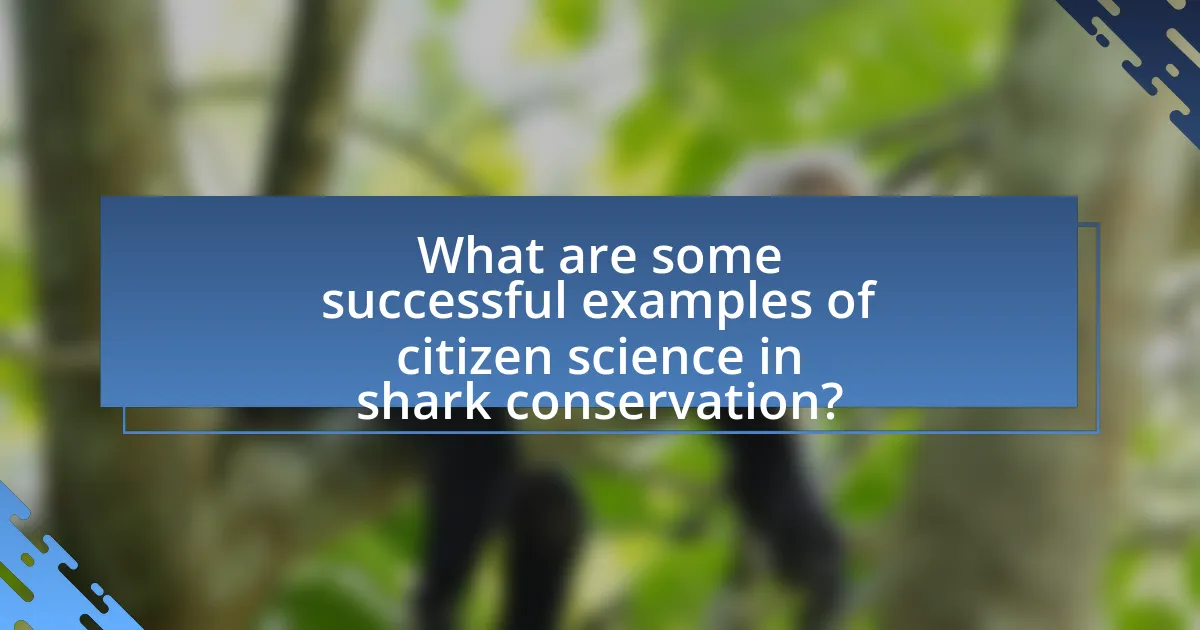
What are some successful examples of citizen science in shark conservation?
Successful examples of citizen science in shark conservation include the Shark Spotters program in South Africa and the OCEARCH initiative. The Shark Spotters program engages local volunteers to monitor shark activity along beaches, providing real-time data that enhances public safety and informs conservation efforts. This program has successfully reduced shark-related incidents and increased awareness about shark behavior. OCEARCH, on the other hand, utilizes citizen scientists to track and collect data on shark movements through tagging and tracking initiatives. This has resulted in valuable insights into shark migration patterns and population dynamics, contributing to more effective conservation strategies. Both initiatives demonstrate the impactful role of citizen science in enhancing shark conservation efforts through community involvement and data collection.
What notable projects have utilized citizen science for shark research?
Notable projects that have utilized citizen science for shark research include the Shark Trust’s “Shark Watch” program and the “Shark Spotters” initiative in South Africa. The Shark Watch program engages volunteers to report shark sightings, contributing valuable data on shark populations and distribution. The Shark Spotters initiative combines citizen reports with scientific research to monitor shark activity near beaches, enhancing public safety and informing conservation strategies. Both projects demonstrate the effectiveness of citizen involvement in gathering critical data for shark conservation efforts.
How did these projects impact shark conservation efforts?
Citizen science projects significantly enhanced shark conservation efforts by increasing public engagement and data collection. These initiatives mobilized volunteers to gather critical information on shark populations, behaviors, and habitats, which informed conservation strategies. For instance, the Shark Trust’s citizen science program has documented over 10,000 shark sightings, providing essential data that led to the identification of key habitats and migration routes. This data-driven approach has resulted in more effective policy-making and habitat protection measures, ultimately contributing to the preservation of shark species.
What lessons were learned from these successful initiatives?
Successful initiatives in shark conservation through citizen science have demonstrated the importance of community engagement and data collection. These initiatives revealed that involving local communities fosters a sense of ownership and responsibility towards marine ecosystems, leading to increased conservation efforts. For instance, programs like the Shark Trust’s citizen science projects have shown that participants can effectively contribute to data collection, enhancing the understanding of shark populations and their habitats. Additionally, these initiatives highlighted the need for clear communication and education about shark conservation, as informed citizens are more likely to participate actively and advocate for protective measures.
How can individuals get involved in citizen science for shark conservation?
Individuals can get involved in citizen science for shark conservation by participating in data collection and reporting initiatives organized by various conservation organizations. For example, programs like the Shark Trust’s “Shark Sightings” app allow users to log shark sightings, contributing valuable data to researchers studying shark populations and behaviors. Additionally, individuals can engage in beach clean-ups and educational outreach efforts to raise awareness about shark conservation, which are often coordinated by local marine conservation groups. These activities not only support scientific research but also foster community involvement in protecting shark species, which are vital to marine ecosystems.
What resources are available for aspiring citizen scientists?
Aspiring citizen scientists can access various resources to support their involvement in shark conservation efforts. Key resources include online platforms such as iNaturalist and Zooniverse, which facilitate data collection and species identification. Additionally, organizations like the Ocean Conservancy and the Shark Trust provide educational materials, training programs, and opportunities for participation in conservation projects. Research studies, such as those published in the journal “Citizen Science: Theory and Practice,” highlight the effectiveness of citizen science in biodiversity monitoring, reinforcing the value of these resources for aspiring participants.
What best practices should individuals follow when participating in these efforts?
Individuals participating in shark conservation efforts should prioritize accurate data collection and reporting. This involves using standardized methods for observing and documenting shark species, behaviors, and habitats, which enhances the reliability of the data. For instance, the use of established protocols, such as those outlined by the Global Shark Tracker, ensures consistency and comparability across different citizen science projects. Additionally, individuals should engage in continuous education about local shark species and conservation issues, as informed participants contribute more effectively to research and advocacy. Studies show that informed citizen scientists can significantly improve data quality, leading to better conservation outcomes.
